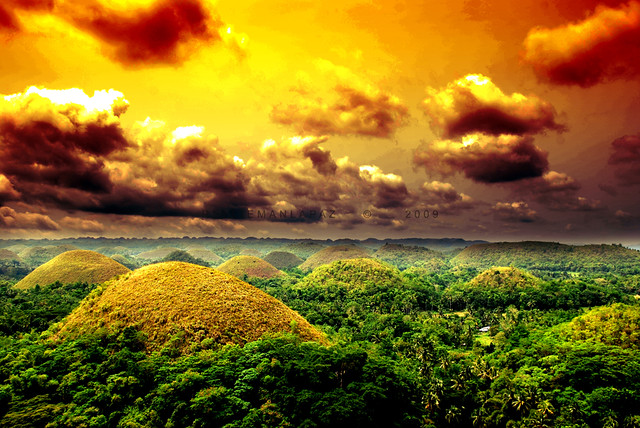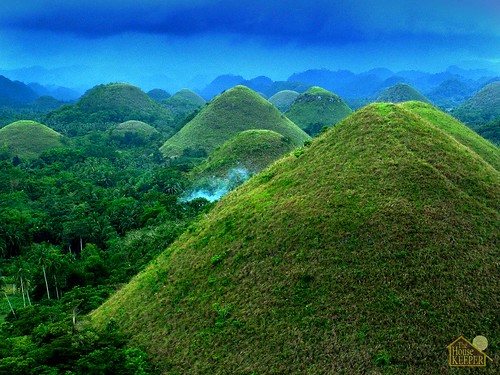1. Chocolate Hills
The Chocolate Hills are an unusual geological formation in Bohol,Philippines. According to the latest accurate survey done, there are 1,776 hills spread over an area of more than 50 square kilometres (20 sq mi). They are covered in green grass that turns brown during the dry season, hence the name.
photo source The Chocolate Hills are an unusual geological formation in Bohol,Philippines. According to the latest accurate survey done, there are 1,776 hills spread over an area of more than 50 square kilometres (20 sq mi). They are covered in green grass that turns brown during the dry season, hence the name.
 |
| Chocolate Hills, Philippines |
During the dry season, the grass-covered hills dry up and turn chocolate brown. This transforms the area into seemingly endless rows of "chocolate kisses".
Grass species found to thrive on the hills are Imperata cylindrical and Saccharum spontaneum and several Compositae and ferns. Trees grow on the base of the hills and are lush and verdant rings around the almost bare cone-shaped hills resulting in its awesome natural beauty.
The Chocolate Hills is a rolling terrain of haycock hills – mounds of general shape which are conical and almost symmetrical. Estimated to be at least 1,268 individual mounds to about 1,776, these cone-shaped or dome-shaped hills are actually made of grass-covered limestone.
 Hills during the dry season |
Grass species found to thrive on the hills are Imperata cylindrical and Saccharum spontaneum and several Compositae and ferns. Trees grow on the base of the hills and are lush and verdant rings around the almost bare cone-shaped hills resulting in its awesome natural beauty.
 |
| Road through the chocolate hills photo source |
 |
| photo source |
The domes vary in sizes from 30 to 50 metres (98 to 160 ft) high with the largest being 120 metres (390 ft) in height. Bohol's "main attraction," these unique mound-shaped hills are scattered by the hundreds throughout the towns of Carmen, Batuan and Sagbayan in Bohol.
 |
| Aerial photo of hills photo source |
The most acceptable geological theory of the hills is that the hills were the result of thousands of years of weathering of marine limestone. Others say that the hills were formed ages ago by the uplift of coral deposits or that they erupted from the sea in a massive geologic shift, and the action of rain water and erosion for the past thousand years put in the finishing touches.
2. Bohol's Tarsier
The Philippine tarsier, (Tarsius syrichta) is very peculiar small animal. In fact it is one of the smallest known primates, no larger than a adult men's hand. Mostly active at night, it lives on a diet of insects. Folk traditions sometimes has it that tarsiers eat charcoal, but actually they retrieve the insects from (sometimes burned) wood. It can be found in the islands of Samar, Leyte, Bohol, and Mindanao in the Philippines.
 |
| Bohol's tarsier |
 |
| A mother and child Tarsier photo source |
"The world's smallest monkey" is an often heard slogan. However, it is not a monkey. In truth, its classification is somewhat problematic. Some scientists consider tarsiers to be a taxonomic suborder among the primates. While, because they are closely related to lemurs, lorises and bushbabies, others classify them with the prosimians to which these animals belong.
 |
 Sleepiness |
 |
| Afternoon rest photo source |
Better meet the tarsiers, see these two interesting videos below!
Tarsier in nature












.jpg)




I'd visited the Philippines and been to Bohol about a year ago and I saw a lot of beautiful spots and places. The hills really looked great. I was glad to see those brown hills. That's the reason why they call it Chocolate hills.
ReplyDeleteholiday park
This place seems like a very nice spot. I am a nature lover and Bohol has a lot of good nature spots. I am also intrigued with this little creature called tarsier. I'd love to go to Bohol and see what it can offer. I'm pretty sure there are plenty of good hotels in there.
ReplyDeletethailand holidays